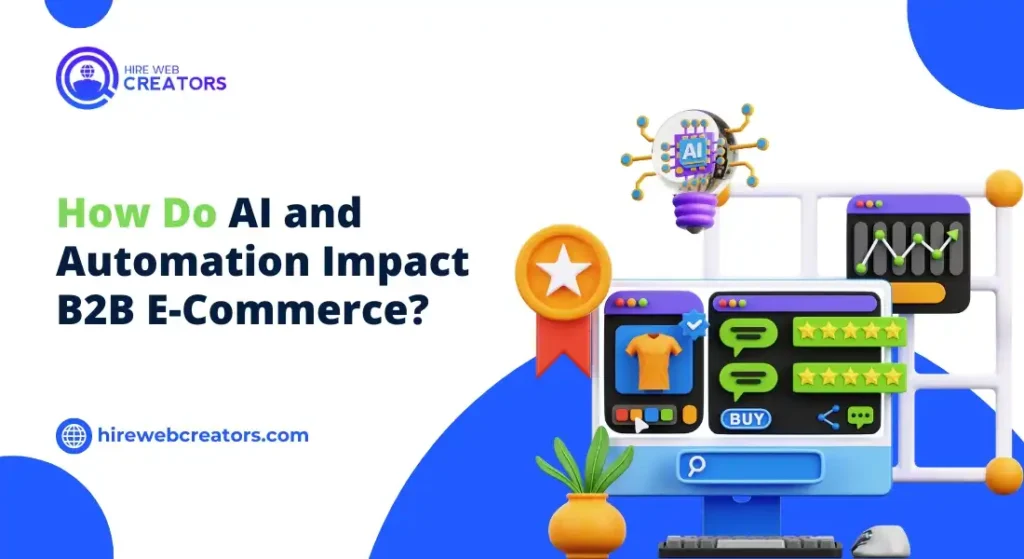
E-Commerce Trends: 10 Revolutionary Changes for B2B Success
Discover the latest E-Commerce trends shaping B2B website development. Explore future-ready strategies and innovations for a competitive edge.
In the rapidly evolving world of B2B website development, understanding the latest E-Commerce trends is crucial for staying competitive. As digital landscapes shift, businesses must adapt to emerging technologies and strategies to enhance their online presence and meet customer expectations. This blog delves into the transformative trends shaping the future of E-Commerce, providing actionable insights to help businesses navigate and capitalize on these changes.
From advancements in AI and automation to the growing emphasis on personalization and security, we explore how these developments are redefining B2B E-Commerce. By leveraging these trends, businesses can create innovative, customer-centric websites that drive growth and success in an increasingly digital marketplace.
What Are the Latest E-Commerce Trends?
The landscape of E-Commerce is evolving at an unprecedented pace, driven by technological advancements and changing consumer behaviors. In today’s B2B environment, staying abreast of the latest E-Commerce trends is essential for businesses aiming to maintain a competitive edge. These trends not only influence how companies interact with their clients but also shape the strategies employed for online success. As businesses seek to adapt to these changes, understanding the emerging E-Commerce trends becomes crucial for optimizing their B2B website development.

One significant trend in E-Commerce is the increasing integration of artificial intelligence (AI) and machine learning. AI-powered tools are revolutionizing how businesses analyze customer data, personalize user experiences, and automate various processes. By harnessing these technologies, B2B companies can gain deeper insights into customer preferences and behaviors, enabling them to tailor their offerings more effectively. For instance, AI-driven chatbots are enhancing customer service by providing instant, personalized responses to inquiries, while predictive analytics helps businesses anticipate customer needs and improve sales strategies. Incorporating these AI-driven E-Commerce trends into B2B website development can lead to more efficient operations and a better customer experience.
Another noteworthy trend is the rise of omnichannel strategies, which emphasize the seamless integration of multiple communication channels. As customers interact with businesses across various platforms—such as social media, mobile apps, and websites—it is crucial for B2B companies to provide a cohesive experience. Omnichannel approaches ensure that customer interactions are consistent and personalized, regardless of the channel used. This trend highlights the importance of integrating various touchpoints to create a unified customer journey. Additionally, the growing emphasis on mobile commerce underscores the need for B2B websites to be mobile-friendly and optimized for a range of devices, reflecting the broader E-Commerce trend of increasing mobile engagement.
The latest E-Commerce trends also underscore the significance of data security and privacy. With growing concerns about data breaches and regulatory compliance, businesses must prioritize robust security measures to protect sensitive information. Implementing advanced encryption protocols, secure payment gateways, and regular security audits are essential steps in safeguarding customer data. As E-Commerce continues to evolve, staying informed about the latest security trends and best practices is vital for maintaining trust and credibility with clients.
How Is B2B E-Commerce Evolving?
The B2B E-Commerce landscape is undergoing significant transformation, driven by evolving market demands and technological advancements. Businesses are increasingly leveraging digital platforms to streamline transactions, enhance customer engagement, and optimize operations. One of the most prominent E-Commerce trends in B2B is the shift toward more sophisticated and user-friendly online marketplaces. These platforms are designed to facilitate smoother interactions between buyers and sellers, providing features such as advanced search capabilities, detailed product catalogs, and automated order processing. As B2B companies adopt these innovations, they can offer a more efficient and seamless shopping experience.
Another key development in B2B E-Commerce is the growing emphasis on personalization. Modern E-Commerce platforms are incorporating sophisticated algorithms and AI tools to tailor content and product recommendations to individual users. This personalized approach not only improves the customer experience but also drives higher engagement and conversion rates. Businesses are using data analytics to understand customer preferences and behaviors, allowing them to create customized offers and promotions. By aligning their strategies with these E-Commerce trends, B2B companies can build stronger relationships with their clients and enhance their overall service quality.
The integration of advanced technologies such as blockchain and IoT is also reshaping B2B E-Commerce. Blockchain technology is being utilized to enhance transparency and security in transactions, reducing the risk of fraud and improving supply chain management. Similarly, IoT devices are providing valuable data insights that help businesses monitor and manage inventory more effectively. These technological advancements are contributing to the evolution of B2B E-Commerce by enabling more secure, efficient, and data-driven operations. Embracing these trends allows B2B companies to stay competitive and adapt to the changing demands of the market.
What Role Does Technology Play in E-Commerce Development?
Technology is a driving force behind the evolution of E-Commerce, influencing every aspect of website development and online operations. The implementation of cutting-edge technologies is essential for creating innovative and competitive E-Commerce platforms. AI and machine learning, for instance, are revolutionizing how businesses analyze data, automate processes, and engage with customers. AI-powered tools enable personalized shopping experiences, automate customer service through chatbots, and provide insights into consumer behavior. These technological advancements are crucial for B2B companies looking to enhance their E-Commerce capabilities and deliver a superior user experience.
Cloud computing is another technology playing a significant role in E-Commerce development. By leveraging cloud-based solutions, businesses can scale their operations efficiently and manage resources more effectively. Cloud platforms offer flexibility, cost savings, and robust performance, making them ideal for handling the demands of modern E-Commerce. With cloud technology, B2B companies can easily integrate various functionalities, such as inventory management, customer relationship management (CRM), and payment processing, into their websites. This integration facilitates smoother operations and ensures that businesses can quickly adapt to changing market conditions.
The adoption of advanced security technologies is also critical in E-Commerce development. As cyber threats become more sophisticated, businesses must implement comprehensive security measures to protect sensitive data and maintain customer trust. Technologies such as encryption, multi-factor authentication, and secure payment gateways are essential for safeguarding online transactions and preventing data breaches. Staying abreast of the latest security trends and best practices is crucial for B2B companies aiming to build a secure and reliable E-Commerce platform.
How Do AI and Automation Impact B2B E-Commerce?
Artificial Intelligence (AI) and automation are profoundly influencing the B2B E-Commerce landscape, driving efficiency and enhancing customer experiences. AI technologies are being integrated into various aspects of E-Commerce platforms to optimize processes and provide valuable insights. AI-driven algorithms are used to personalize content, recommend products, and analyze customer data, resulting in more tailored and engaging experiences for users. Automation tools streamline repetitive tasks, such as order processing and inventory management, allowing businesses to focus on strategic initiatives and improve operational efficiency.

One of the most significant impacts of AI in B2B E-Commerce is its role in enhancing customer service. AI-powered chatbots and virtual assistants are providing instant support and resolving customer inquiries with precision. These tools use natural language processing (NLP) to understand and respond to user queries, offering a seamless and efficient support experience. Automation is also being utilized to manage customer interactions, such as follow-up emails and personalized offers, based on user behavior and preferences. This combination of AI and automation improves response times, reduces operational costs, and boosts overall customer satisfaction.
Data analytics powered by AI is another crucial aspect influencing B2B E-Commerce. Businesses are leveraging AI to analyze large volumes of data and extract actionable insights. These insights help companies understand customer preferences, forecast demand, and optimize pricing strategies. By harnessing the power of AI, B2B companies can make informed decisions, drive strategic growth, and enhance their competitive advantage in the market.
What Are the Key Benefits of Cloud-Based E-Commerce Solutions?
Cloud-based E-Commerce solutions are transforming the way businesses operate, offering a range of benefits that enhance efficiency and scalability. One of the primary advantages of cloud computing is its ability to provide flexible and scalable infrastructure. Businesses can easily adjust their resources based on demand, ensuring that their E-Commerce platforms can handle varying traffic levels and transaction volumes. This flexibility is particularly valuable for B2B companies that experience fluctuations in activity and need to maintain high performance during peak periods.
Cost savings are another significant benefit of cloud-based E-Commerce solutions. By utilizing cloud services, businesses can reduce the need for extensive on-premises infrastructure and associated maintenance costs. Cloud providers offer a pay-as-you-go model, allowing companies to only pay for the resources they use. This cost-effective approach enables B2B companies to allocate their budgets more efficiently and invest in other areas of their business. Additionally, cloud solutions offer built-in security features and regular updates, further reducing the burden of managing and maintaining IT infrastructure.
Cloud-based E-Commerce platforms also enhance collaboration and integration capabilities. These solutions facilitate seamless integration with various business applications, such as CRM systems, ERP software, and payment gateways. This integration streamlines operations, improves data accuracy, and enables better coordination across different departments. For B2B companies, the ability to integrate and collaborate effectively is crucial for managing complex transactions and delivering a cohesive customer experience.
How Are Personalization and Customer Experience Shaping E-Commerce?
Personalization and customer experience are central to the evolving E-Commerce landscape, significantly influencing how businesses engage with their clients. Personalization involves tailoring content, product recommendations, and marketing efforts to individual user preferences and behaviors. By leveraging data analytics and AI, businesses can create highly targeted experiences that resonate with their audience. This level of customization enhances user satisfaction, increases engagement, and drives higher conversion rates, making personalization a key component of successful E-Commerce strategies.

The customer experience is equally important in shaping E-Commerce trends, as businesses strive to deliver seamless and enjoyable interactions across all touchpoints. Factors such as website design, navigation, and responsiveness play a crucial role in creating a positive user experience. B2B companies are investing in intuitive and user-friendly interfaces that facilitate easy navigation and efficient transactions. Ensuring that customers have a smooth and enjoyable experience on the website is essential for building trust and fostering long-term relationships.
E-commerce platforms are also focusing on providing exceptional customer support as part of the overall experience. Features such as live chat, comprehensive FAQs, and self-service options are becoming standard to address customer inquiries and issues promptly. By prioritizing customer support and investing in user experience improvements, businesses can differentiate themselves from competitors and create lasting impressions on their clients.
What Are the Emerging Security Trends in E-Commerce?
Security remains a top priority in E-Commerce as businesses address the increasing threats and challenges associated with online transactions. Emerging security trends are shaping how B2B companies protect sensitive data and maintain the integrity of their E-Commerce platforms. One significant trend is the adoption of advanced encryption technologies. Encryption ensures that data transmitted between users and websites is securely encoded, reducing the risk of interception and unauthorized access. Implementing strong encryption protocols is essential for safeguarding customer information and maintaining trust.
E-commerce trends have significantly evolved, especially in the realm of security. One of the most critical E-Commerce Trends is the implementation of multi-factor authentication (MFA) to enhance access security. As part of the broader E-Commerce Trends, MFA requires users to provide multiple forms of verification, such as passwords and biometric data, before gaining access to their accounts. This essential E-Commerce Trend adds a layer of security, helping to prevent unauthorized access and reducing the likelihood of data breaches. B2B E-Commerce platforms are increasingly incorporating MFA, reflecting one of the leading E-Commerce Trends aimed at protecting sensitive business information and preventing fraud.
Another prominent aspect of E-Commerce Trends is the regular implementation of security audits and vulnerability assessments. These E-Commerce Trends are becoming standard practice to identify and address potential weaknesses in E-Commerce systems. By staying ahead of these E-Commerce Trends, businesses can protect their platforms from emerging threats and ensure that their security measures remain current. Conducting thorough audits and addressing vulnerabilities proactively are essential E-Commerce Trends that B2B companies should follow to enhance their security posture and mitigate risks associated with online transactions. By aligning with these E-Commerce Trends, businesses can maintain a robust and secure online presence.
How Do Mobile and Omnichannel Strategies Influence B2B E-Commerce?
Mobile and omnichannel strategies are increasingly shaping the B2B E-Commerce landscape, reflecting the growing importance of seamless and integrated customer experiences. Mobile commerce, or m-commerce, is a significant trend as more users access E-Commerce platforms via smartphones and tablets. B2B companies are optimizing their websites for mobile devices to ensure that users have a smooth and engaging experience regardless of the device they use. Mobile-friendly design, fast load times, and responsive interfaces are essential for accommodating the preferences of today’s mobile-first consumers.
E-commerce trends are reshaping how businesses approach omnichannel strategies, emphasizing the need for a cohesive customer journey across multiple touchpoints. As part of these E-Commerce Trends, businesses are integrating various channels, such as online marketplaces, social media, and mobile apps, to provide a unified experience. This alignment with E-Commerce Trends ensures that customers can interact with brands seamlessly, whether they are browsing on a website, contacting customer support, or making purchases through a mobile app.
The adoption of these E-Commerce Trends enhances customer satisfaction and loyalty by offering consistent and personalized experiences across different channels. Additionally, the integration of mobile and omnichannel strategies into B2B E-Commerce Trends involves leveraging data to understand customer behaviors and preferences. By analyzing interactions across various touchpoints, businesses can gain valuable insights and optimize their marketing and sales efforts. Following these E-Commerce Trends, B2B companies can tailor their strategies to meet the evolving needs of their clients and maintain a competitive edge in the dynamic e-commerce landscape. Staying aligned with E-Commerce Trends is crucial for businesses aiming to succeed in this rapidly changing environment.
What Innovations Are Driving the Future of B2B E-Commerce?
The future of B2B E-Commerce is being shaped by a range of innovations that are transforming how businesses operate and engage with their clients. Emerging technologies such as artificial intelligence (AI), blockchain, and the Internet of Things (IoT) are driving significant changes in E-Commerce practices. AI is enhancing personalization, automating processes, and providing valuable insights through data analytics. Blockchain technology is improving transparency and security in transactions, while IoT devices are offering real-time data and enhanced supply chain management capabilities.

Another innovation influencing the future of B2B E-Commerce is the rise of augmented reality (AR) and virtual reality (VR). AR and VR technologies are providing immersive experiences that enable customers to visualize products and interact with virtual environments. For B2B companies, these technologies offer new opportunities for product demonstrations, virtual trade shows, and enhanced customer engagement. Integrating AR and VR into E-Commerce platforms can create unique and compelling experiences that set businesses apart from their competitors.
The growth of subscription-based models is also impacting the B2B E-Commerce landscape. Subscription services offer businesses a recurring revenue stream and foster long-term relationships with customers. By providing flexible and scalable solutions, B2B companies can meet the evolving needs of their clients and drive sustained growth. Innovations in subscription management and billing are enabling businesses to streamline operations and enhance their service offerings.
How Can Businesses Leverage Data Analytics for E-Commerce Success?
Data analytics is a powerful tool for driving success in E-Commerce, offering valuable insights that can inform strategies and optimize performance. In B2B E-Commerce, leveraging data analytics involves analyzing customer behavior, transaction patterns, and market trends to make informed decisions. By utilizing advanced analytics tools, businesses can gain a deeper understanding of their clients’ preferences and needs. This information enables companies to tailor their offerings, personalize marketing efforts, and improve overall customer satisfaction.
E-commerce trends are transforming the way businesses leverage predictive analytics for success. By analyzing historical data and identifying patterns, businesses can forecast future E-Commerce Trends and make proactive decisions. For example, E-Commerce Trends in predictive analytics help B2B companies anticipate demand, optimize inventory levels, and develop targeted marketing campaigns. Staying ahead of E-Commerce Trends allows businesses to remain competitive and respond effectively to changing market conditions.
E-commerce trends also play a crucial role in optimizing website performance and user experience. Businesses can use E-Commerce Trends in analytics to monitor key metrics such as conversion rates, bounce rates, and user engagement. By identifying areas for improvement through E-Commerce Trends, companies can implement changes to enhance the functionality and appeal of their E-Commerce platforms. Regularly analyzing and acting on E-Commerce Trends ensures that B2B companies can continuously refine their strategies and achieve long-term success in the digital marketplace.
What Are the Key Considerations for Implementing E-Commerce Strategies?
Implementing effective E-Commerce strategies requires careful consideration of various factors that impact the success of online operations. One key consideration is the selection of the right E-Commerce platform. Businesses must choose a platform that aligns with their specific needs and goals, offering features such as scalability, customization, and integration capabilities. Evaluating different platforms and selecting one that supports the required functionalities is essential for ensuring a smooth and successful E-Commerce implementation.

Another important consideration is the optimization of user experience on E-Commerce websites. Factors such as website design, navigation, and performance play a critical role in attracting and retaining customers. B2B companies should focus on creating intuitive and user-friendly interfaces that facilitate easy transactions and provide a positive overall experience. Additionally, ensuring that the website is optimized for various devices, including mobile phones and tablets, is crucial for meeting the expectations of today’s digital consumers.
Security and compliance are also critical considerations when implementing E-Commerce strategies. Businesses must prioritize the protection of customer data and adhere to relevant regulations, such as GDPR or CCPA. Implementing robust security measures, such as encryption and secure payment gateways, helps safeguard sensitive information and build trust with customers. Ensuring compliance with regulatory requirements is essential for avoiding potential legal issues and maintaining a positive reputation in the E-Commerce market.
In conclusion, The landscape of B2B E-Commerce is rapidly evolving, driven by innovative technologies and shifting market demands. E-commerce trends such as advanced personalization, mobile and omnichannel strategies, and the integration of cutting-edge technologies like AI and blockchain are reshaping how businesses interact with their clients. These advancements are not just enhancing operational efficiency but also improving customer experiences and driving growth. As B2B companies navigate these changes, adopting and leveraging these trends will be crucial for staying competitive and meeting the evolving needs of their clientele.
Looking ahead, the future of E-Commerce in B2B website development promises even more opportunities for innovation and optimization. Businesses that embrace these trends and technologies will be better positioned to thrive in a dynamic digital environment. By focusing on personalization, leveraging data analytics, and integrating advanced technologies, B2B companies can create compelling E-Commerce platforms that drive success and foster long-term relationships with their customers. The key to future success will lie in the ability to adapt and evolve with these emerging trends, ensuring that their E-Commerce strategies remain relevant and impactful.
